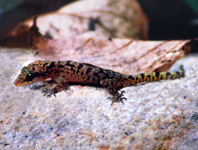Abstract
Romanogobio skywalkeri, new species, is described from the upper Mur River in the Austrian Danube drainage. It is related to R. banarescui from the Mediterranean basin. Romanogobio skywalkeri is distinguished from R. banarescui by lacking epithelial crests on the predorsal back, having 12–14 total pectoral-fin rays (vs. 10–11) and usually 8½ branched dorsal-fin rays (vs. 7½). It is distinguished from other Romanogobio species in the Danube drainage by having a very slender body; a moderately long barbel, extending slightly beyond the posterior eye margin; and no epithelial crests on the predorsal back. Romanogobio skywalkeri is distinguished by a minimum net divergence of 6.3% (uncorrected p-distance against R. banarescui) in the COI barcoding region from other European Romanogobio species. A key to the Romanogobio species of the Danube drainage is provided. Romanogobio banarescui from the Vardar drainage and R. carpathorossicus from the Danube drainage are treated as valid species.
References
Bănărescu, P.M. (1961) Weitere systematische Studien über die Gattung Gobio (Pisces, Cyprinidae) insbesondere im Donaubecken. Věstník Československé zoologické společnosti, 25 (4), 318–346.
Bănărescu, P.M. (1999) Gobio kessleri Dybowski, 1862. In: Bănărescu, P.M. (Ed.), The freshwater fishes of Europe. Vol. 5/I, Cyprinidae 2. Aula, Wiebelsheim, pp. 135–162.
Bănărescu, P.M., Bless, R. & Economidis, P.S. (1999) Gobio uranoscopus Agassiz, 1828. In: Bănărescu, P.M. (Ed.), The freshwater fishes of Europe. Vol. 5/I, Cyprinidae 2. Aula, Wiebelsheim, pp. 183–202.
Duftner, N., Koblmüller S. & Sturmbauer, C. (2005) Evolutionary relationships of the Limnochromini, a tribe of benthic deepwater cichlid fish endemic to Lake Tanganyika, East Africa. Journal of Molecular Evolution, 60, 277–289.
https://doi.org/10.1007/s00239-004-0017-8
Geiger, M.F., Herder, F., Monaghan, M.T., Almada, V., Barbieri, R., Bariche, M., Berrebi, P., Bohlen, J., Casal-Lopez, M., Delmastro, G.B., Denys, G.P.J., Dettai, A., Doadrio, I., Kalogianni, E., Kärst, H., Kottelat, M., Kovačić, M., Laporte, M., Lorenzoni, M., Marčić, Z., Özuluğ, M., Perdices, A., Perea, S., Persat, H., Porcelotti, S., Puzzi, C., Robalo, J., Šanda, R., Schneider, M., Šlechtová, V., Stoumboudi, M., Walter, S. & Freyhof, J. (2014) Spatial heterogeneity in the Mediterranean Biodiversity Hotspot affects barcoding accuracy of its freshwater fishes. Molecular Ecology Resources, 14, 1210–1221.
https://doi.org/10.1111/1755-0998.12257
Guindon, S., Dufayard, J.F., Lefort, V., Anisimova, M., Hordijk, W. & Gascuel. O. (2010) New algorithms and methods to estimate maximum-likelihood phylgoenies: assessing the performance of PhyML 3.0. Systematic Biology, 59, 307–21.
https://doi.org/10.1093/sysbio/syq010
Knebelsberger, T., Dunz, A.R., Neumann, D. & Geiger, M.F. (2015) Molecular diversity of Germany’s freshwater fishes and lampreys assessed by DNA barcoding. Molecular Ecology Resources, 3, 562–572.
https://doi.org/10.1111/1755-0998.12322
Koblmüller, S., Salzburger, W., Obermüller, B., Eigner, E., Sturmbauer, C. & Sefc, K.M. (2011) Separated by sand, fused by dropping water: habitat barriers and fluctuating water levels steer the evolution of rock-dwelling cichlid populations. Molecular Ecology, 20, 2272–2290.
https://doi.org/10.1111/j.1365-294X.2011.05088.x
Kottelat, M. & Freyhof, J. (2007) Handbook of European freshwater fishes. Kottelat, Cornol and Freyhof, Berlin, xiv + 646 pp.
Kuhner, M.K. (2009) Coalescent genealogy samples: window into population history. Trends in Ecology and Evolution, 24, 86–93.
https://doi.org/10.1016/j.tree.2008.09.007
Lefort, V., Longueville, J.-E. & Gascuel, O. (2017) SMS: smart model selection in PhyML. Molecular Biology and Evolution, 34, 2422–2424.
https://doi.org/10.1093/molbev/msx149
Naseka, A.M., Bănărescu, P.M. & Bogutskaya, N. (1999) Gobio persus Gunther, 1899. In: Bănărescu, P.M. (Ed.), The freshwater fishes of Europe. Vol. 5/I, Cyprinidae 2. Aula, Wiebelsheim, pp. 163–181.
Naseka, A.M. & Freyhof, J. (2004) Romanogobio parvus, a new gudgeon from River Kuban, southern Russia (Cyprinidae, Gobioninae). Ichthyological Exploration of Freshwaters, 15, 17–23.
Richlen, M.L. & Barber, P.H. (2005) A technique fort the rapid extraction of microalgal DNA from single live and preserved cells. Molecular Ecology Notes, 5, 688–691.
https://doi.org/10.1111/j.1471-8286.2005.01032.x
Ronquist, F., Teslenko, M., van der Mark, P., Ayres, D.L., Darling, A., Höhna, S., Larget, B., Liu, L., Suchard M.A. & Huelsenbeck J.P. (2012) MrBayes 3.2: efficient Bayesian phylogenetic inference and model choice across large model space. Systematic Biology, 61, 539–542.
https://doi.org/10.1093/sysbio/sys029
Stout, C.C., Tan, M., Lemmon, A.R., Lemmon, E.M. & Armbruster, J.W. (2016) Resolving Cypriniformes relationships using an anchored enrichment approach. BMC Evolutionary Biology, 16, 244.
https://doi.org/10.1186/s12862-016-0819-5
Tamura, K.G. Stecher, D. Peterson, A. Filipski, A. & Kumar, S. (2013) MEGA6: molecular evolutionary genetic analysis version 6.0. Molecular Biology and Evolution, 30, 2725–2729.
https://doi.org/10.1093/molbev/mst197
Tang, K.L., Agnew, M.K., Chen, W.-J., Hirt, M.V., Raley, M.E., Sado, T., Schneider, L.M., Yang, L., Bart, H.L., He, S., Liu, H., Miya, M., Saitoh, K., Simons, A.M., Wood, R.M. & Mayden, R.L. (2011) Phylogeny of the gudgeons (Teleostei: Cyprinidae: Gobioninae). Molecular Phylogenetics and Evolution, 61, 103–124.
https://doi.org/10.1016/j.ympev.2011.05.022
Villesen, P. (2007) FaBox: an online toolbox for fasta sequences. Molecular Ecology Notes, 7, 965–968.
https://doi.org/10.1111/j.1471-8286.2007.01821.x
Ward, R.D., Zemlak, T.S., Innes, B.H., Last, P.R. & Hebert, P.D.N. (2005) DNA barcoding Australia’s fish species. Philosophical Transactions of the Royal Society B—Biological Sciences, 360, 1847–1857.
https://doi.org/10.1098/rstb.2005.1716

